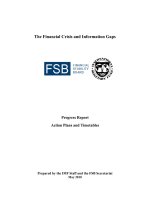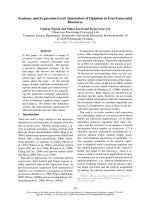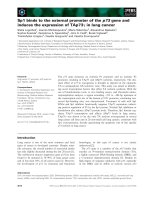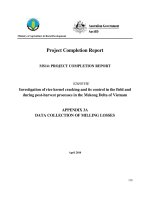Project Progress Report: " Establish nurseries and training to effectively propagate high quality trees and trial plantation models of Macadamia in 3 provinces of North Vietnam - Milestone 9 " potx
Bạn đang xem bản rút gọn của tài liệu. Xem và tải ngay bản đầy đủ của tài liệu tại đây (51.53 KB, 10 trang )
1
Ministry of Agriculture & Rural Development
Project Progress Report
Macadamia Project 037VIE05
Milestone 9
THIRD SIX-MONTHLY REPORT
January to June 2008
1
Table of Contents
1. Institute Information________________________________________________________________ 1
2. Project Abstract____________________________________________________________________ 2
3. Executive Summary_________________________________________________________________ 2
Introduction & Background _______________________________________________________________ 4
4. Progress to Date____________________________________________________________________ 4
4.1 Implementation Highlights ________________________________________________ 4
4.2 Smallholder Benefits______________________________________________________ 5
4.3 Capacity Building ________________________________________________________ 5
4.4 Publicity________________________________________________________________ 5
4.5 Project Management _____________________________________________________ 6
5. Report on Cross-Cutting Issues _______________________________________________________ 6
5.1 Environment ____________________________________________________________ 6
5.2 Gender and Social Issues __________________________________________________ 6
6. Implementation & Sustainability Issues ________________________________________________ 7
6.1 Issues and Constraints ____________________________________________________ 7
6.2 Sustainability____________________________________________________________ 7
7. Next Critical Steps __________________________________________________________________ 7
8. Conclusion ________________________________________________________________________ 8
1
1. Institute Information
Project Name
Establish nurseries and training to
effectively propagate high quality trees
and trial plantation models of
Macadamia in 3 provinces of North
Vietnam
Vietnamese Institution
Center for Environment, Tourism and
Development (CETD),
Vietnamese Project Team Leader
Prof Hoang Hoe
Australian Organisation Subtropical Farm Forestry Association
Australian Personnel
Martin Novak, Kim Wilson
Date commenced
10 January 2006
Completion date (original)
10 January 2009
Completion date (revised)
December 2009
Reporting period
January - June 2008
Contact Officer(s)
In Australia: Team Leader
Name:
Martin Novak
Telephone:
61 2 66895027
Position:
President
Fax:
61 2 66895227
Organisation
Subtropical Farm Forestry
Association
Email:
In Australia: Administrative contact
Name:
Valda Mitchell
Telephone:
61 2 66284372
Position: Administrative Officer Fax: 61 2 66284386
Organisation
Subtropical Farm Forestry
Association
Email:
In Vietnam
Name:
Hoang Hoe
Telephone:
04 8642670, 04
7560233
Position:
Director
Fax:
04 7560233
Organisation
CETD
Email:
2
2. Project Abstract
3. Executive Summary
The project continued over the first 6 months of 2008 and included meetings in Australia and
Vietnam between participants communicating progress and key information relating to the
participating organisations.
The Australian team visit, in May, only involved Kim Wislon. The Australian team leader,
Martin Novak, could not attend because of family illness. The visit took place over 10 days,
during which over a 1000 pieces of Australian Scion wood was delivered to the 3 existing
nurseries. This included some of the 10 Australian varieties selected for the trial 344, 741,
849, 842, 816, A4, A203, A268 and also Daddow A successful 1 day Seminar , including a
press meeting, was held at the Head office of VIFA Hanoi, involving a number of the
macadamia industry participants, some newly interested farmers, MARD representatives and
a number of media representatives.
Kim Wilson visited Lang son, Yen Thuy, the FSI and Ba vi nurseries and trial sites. He
provided hands on training and information relating to key aspects of macadamia propagation
during these visits. Kim provided a comprehensive report based on his visits. (Annex: A1,
A1.1, 2, 3, 4, 5, 6, &7)
The main issues that arose during this visit at the nurseries included the need to certify
variety ID. The nurseries could still improve on recording systems, better quality pots and
potting mix. FSI is supplying grafted trees to farmers, however in Lang son there is no
interest for trees and hence they plan to stop propagation. More details with regard to the
nurseries are to be found in the Australian reports attached. (A1.1, 3, 4, &6)
This project continued during the first half of 2008 to support the propagation in the new Macadamia nursery
and in the three existing nurseries. Also 3 principal variety trials of Macadamias have been established, of
about 1 ha each involving 14 suitable Macadamias varieties, in 3 provinces of north Vietnam. In addition the
project is involved with 3 organizations undertaking 18 other trials. Training continues to be conducted in
aspects of propagation, grafting, site design and preparation, planting, maintenance and plantation management
at the nurseries and trial sites. This has included the distribution of CD, DVD and power point presentations as
well as hands on training at 3 formal training workshops, as well as training in the field. 840 kg of seed nut
from Australia and China have been provided to the nurseries along with 6000 sticks of Scion wood of the
selected varieties and samples of nursery equipment during 2006 , 2007 and 2008.
A study tour to China was undertaken covering all the major nurseries and some key plantations in southern
China. Reports of this tour including photos and a DVD video have been presented to the key stakeholders in
Vietnam and Australia. A number of 2 way visits have been made since by way of follow up.
A growing select group of small holder farmers have been chosen to be involved with project activities in the
provinces of Lang Son, Ba vi, Hoa Binh and Dak Lak provinces. In addition the project continues to involve
all known key government agencies involved with Macadamias in Vietnam including MARD, FSI, WASI,
RCFTI, RIFA and RIFV. A number of private sector companies are also involved, as is the Macca Club of
Vietnam.
Significant progress has been made with regard to the capacity building of farmers, extension and technical
staff since the commencement of the project in January 2006.
3
The trials at Ba vi and Lang son generally continue to look good. They both are providing
data now, which can make a significant contribution to the bigger picture for Vietnam. (A1.2,
A1.3) The Yen Thuy trial planting was rescheduled and planted in February & March 08
based on the original design. The trees look healthy (Refer to Annex 1.4 - Australia Team
reports)
A Macadamia Seminar and Press meeting was held 23
rd
May in Hanoi in the VIFA Head
Office. The Special Issue of the Magazine “Forest and Life” on Macadamia (A2.1) was
launched at this meeting. The meeting was attend by Vietnam Television (VTV 2, VCTV),
Vietnam Radio (Rural Program), News Bulletin of Vietnams Agriculture, Magazine
Commerce, Magazine Rural Economics, Department Science & Technology MARD,
National Center for Agriculture Extension, MARD. It was presided over by Hoang Hoe and
Kim Wilson (Refer to Program A2 & Mag Content A2.1)
During this period over 10,000 trees were produced, from 300kg of seed nut from Long Zhou
China and distributed to Ba vi and Yen Thuy nurseries. Also 1000 sticks of scion wood was
obtained from Long Zhou. This included 6 varieties including OC, 788, QN1, 800, 900, 246.
This was in addition to the 1000 sticks of scion were delivered from Australia mentioned
above. Two boxes of grafting tape (Florist Tape) were also posted from Australia.
A request for specific data was circulated to the nurseries and trials sites. (A3) This was
followed up by Kim Wilson during his visit to the sites. The responses have been
incorporated into his reports (A3.1 & A3.2)
After the seminar and press meeting, Hoang Hoe and Kim Wilson met with Keith Milligan
and discussed the project and the importance of plans beyond the life of the project. This was
followed up by a meeting with Dr. Trieu van Hung – Director General, Department of
Science & Technology. The main outcome of this meeting was that extension be made a
priority once the project is concluded.
During this period plans were made for a visit by the Project team to Dak Lak and the WASI
Research Center preceding the concluding workshop, which was planned for October 2008 in
Hanoi.
Communication and exchange of information continued over the 6 months, with a number of
organizations and individuals, including, Central and Western Highlands Agro-Forestry
Science and Technical Institutes, Thai Binh Foods and a number of interested farmers.
Representatives of these organizations and many of these farmers had attend the Ba vi
Workshop.
Prof Hoang Hoe, Vietnamese Project Team Leader continued to collect data and
communicate progress of all aspects of the project. (Refer to his reports A5 photo CD)
During this 6-month period, a lot of data and other information were made available to the
project in addition to that presented in response to the questionnaire and in Kim Wilson’s
reports. (Refer to A1 & 4) Also a number of other significant meetings took place this
information is presented below or attached.
4
Introduction & Background
This project has 2 principal aims, firstly to trial the most suitable macadamia varieties in
Vietnam and secondly to train nursery staff, farmers and others in related aspects of
macadamia horticulture. In addition to this the project has been attempting to bring all
existing and some potential stakeholders together in formal and onsite participatory training
sessions in order to help facilitate Vietnams macadamia industry development in a more
strategically coordinated and scientifically based manner.
Most project participants seem to be of the view that the industry will be viable and
sustainable within Vietnam agricultural sector. In fact it appears to have the potential to
replace or enhance some crops that are struggling at present, for instance that of coffee in the
central highlands.
The project leadership is working closely with other macadamia initiatives that existed prior
or outside of the projects principal scope, such as the work done by FSI and WASI.
The Australian team has been in a position to introduce the participants to key aspects of
Australian practice and research. This is very valuable if Vietnam is to have a good
foundation upon which it can build this new industry. Complimenting this is additional
information being sourced from other countries, especially China, but also from South Africa
and Thailand.
4. Progress to Date
4.1 Implementation Highlights
The Seminar and Press Meeting helped to introduced the industry to a broader audience. The
project team were able to address some concerns that had been raised by farmers and the
press. Including one question which was raised which demonstrated the perceptiveness of the
participants and the principal dilemma confronting the developing industry;
“ It appears to be an expensive crop to set up but we are trying to target poor farmers?”
The meeting with Dr. Hung highlighted the need to set up more demonstration plots and also
the need to find a way to certify the varieties being used in Vietnam. (A1)
Success and problems in the nurseries and trial sites, are detailed in Kim Wilson’s reports
(A1, A1.1,2,3,4,5,6&7) and in responses to the questionnaire. Prof Hoang Hoe has translated
and summarised direct reports from the project participants relating to progress in the
nurseries and trials. (A5)
The new nursery at Yen Thuy is making good progress both in terms of seed raising and
grafting. The trial planting has been completed in a satisfactory manner. (A1.6, A1.7, & A5 )
The other nurseries continue as before, however Lang son has decided not to continue the
propagation of macadamia because of the low demand from farmers. (Details are reported on
in A1) However the trial at Van Dinh will continue to be maintained and monitored by them.
5
4.2 Smallholder Benefits
As referred to above, small farmers are finding it difficult to grow macadamias, which are for
them an expensive crop to plant and one that has relatively long term returns. There have
been a few innovative farmers that have planted a small number of hectares, however the
majority of poor farmers cannot afford the cost or time to become directly involved at this
early stage of the development of the industry. There has been no lack of interest by farmers,
however, until trees become more affordable and returns more visible, farmers in general will
be hesitant to be involved. Nevertheless there are already secondary benefits to the
smallholder through employment in the nurseries, trial and pilot plots as well as private
plantations.
There has been some consideration by the larger players, including Thai Binh Foods and
Donna Foods, to provide grafted trees to farmers, as is the case in China. This is a model
practiced in forestry in Vietnam.
The Australia experience is in some way similar. The industry was virtually non-existent,
until larger players became involved and then supported by government via tax incentives.
4.3 Capacity Building
Significant capacity building continues to be achieved via the project training and
information delivery mechanisms particularly in the nurseries and plot sites, during this
period and through the workshops over the past 2 -3 years.
The large body of information now available as a result of the project, including the Manuals,
Computer Models, Training Videos and Workshop proceedings, available in Vietnamese and
English, contribute significantly to the capacity building within the industry.
All of these have been delivered to CARD in previous reports. All are available through the
CETD office.
A significant amount of experience has been gained by technicians, famers and others, in
working with the 14 select varieties and another 3 new varieties delivered during the last 2.5
years.
4.4 Publicity
A Seminar and Press meeting was held 23
rd
May in Hanoi in the VIFA Head Office. The
Special Issue of the Magazine “Forest and Life” on Macadamia was launched at this meeting.
The meeting was attend by Vietnam Television( VTV 2, VCTV), Vietnam Radio (Rural
Program), News Bulletin of Vietnams Agriculture, Magazine Commerce, Magazine Rural
Economics, Department Science & Technology , MARD,National Center for Agriculture
Extension, MARD. It was presided over by Hoang Hoe and Kim Wilson.
For details of the meeting and contents of the magazine refer to Annex A2 &A2.1.
The nurseries and government agencies continue to undertake their own regional promotion.
6
4.5 Project Management
General management activities in Vietnam and Australia have continued along the lines of
the first 2 years, this has included oversight of implementation at nurseries and trial sites,
extension work, translation of documents, arrangement of ongoing meetings, responses to
design issues, purchasing of equipment, editing of information documents and video. Also
further ongoing communication relating to the trial sites and nursery activities between
participants and collaborators continues.
Specific management relating to all the activities detailed in this report went well during this
period.
Martin Novak could not undertake the Vietnam visit during this period because of his
mothers serious illness. However Kim Wilson did an excellent job in representing the
Australian team and provided the project with a detailed report. (A1&A1.1-7)
5. Report on Cross-Cutting Issues
5.1 Environment
Project participants have been monitoring and reporting on any environmental impacts.
However, so far in Vietnam there continue to be no significant negative environmental
impacts.
FSI has the longest history of research into macadamia in Vietnam. So far they have not
found any significant problems relating to the impact on the environment.
The Australian experience shows that soil erosion, chemical runoff and noise pollution can
become problems in areas that have more mature orchards. Vietnams macadamia industry
needs to plan for these potential problems well ahead of time.
5.2 Gender and Social Issues
There were no new gender or social issues for this period. As stated in earlier reports
approximately half of technicians and workers in the nurseries are women. They play an
equal role to that of the men both in terms of work and capacity building. However
leadership is still dominated by men.
The project leaders continue to encourage participating organizations to utilize the role of
women, on their staff in the project.
7
6. Implementation & Sustainability Issues
6.1 Issues and Constraints
An issue was raised by Minister Bong regarding the need for certification of macadamia
varieties, for MARD to become more involved and undertake extension and other support.
This will need to be followed up with MARD, as to how best to implement such certification.
Australian Team leader, Martin Novak, was not able to visit Vietnam during this period due
to the serious illness of his mother. This was offset by Kim Wilson, providing comprehensive
reports, covering all aspects of the project during his visit in May. (Refer to Annex A1)
Martin Novak has made up the time by an extra trip to Thailand arranging the Thai visit and
will also make up more time in 2009 with an additional workshop planned for Dak Lak and
other additional project activities.
Lang son has found a lack of interest in macadamia by farmers and has stopped producing
grafted trees. This will most probably be offset by development of macadamia projects in
Dak Lak and other provinces. If the industry develops in other parts of Vietnam, as it appears
that it will, Lang son farmers may be encouraged to take up macadamias once again.
However the region does seem to have a problem with high humidity and light rain occurring
during the flowering of macadamia trees.
The issue confronting small farmers in terms of relatively high costs to start and long time
frames for cash flow to become positive, was raised at the Seminar and Press Meeting
referred to above. This highlights the need for government support for small farmers and also
incentives for bigger players in the developmental stages of the macadamia industry. Tax
incentives were the kick-start to the macadamia industry in Australia. Vietnam also needs
some type of mechanism to address this problem.
The role of the Macca Club, during this period has not been very conspicuous. The project
leaders continue to encourage the Club to broaden and formalise its role and start taking on
the leadership in the development of the industry.
6.2 Sustainability
The macadamia industry in Vietnam is still in its early stages of development, however the
project leadership is not aware of any significant issues or constraints that impact negatively
on the sustainable development of this industry to date. To the contrary, all indications are
that the industry will become viable, especially if the experience of Australia and China is
used as a model for development.
7. Next Critical Steps
The final Training Workshop plans have been completed and it is schedule to be held in
October 2008. It is to be held in Hanoi and all project participants and international delegates
from China, Thailand and Australia are invited.
8
This will also be the time of the next Australian team visit to Vietnam. In addition to training
at the workshop sessions additional training will take place at the 3 existing macadamia
nurseries and at the new nursery in Yen Thuy.
The existing nurseries have completed the trial plantings and monitoring has commenced.
The publishing of another special issue on macadamia in the Forest and Life magazine is
planned for 2009.
A visit by the project team to the Central Highlands is planned to view the work of WASI
and other innovative farmers of that region.
A study tour of Thailand’s macadamia plantations and research sites is planned for 2008,
involving Dr Kha, Director Minh and Prof. Hoang Hoe as the Vietnamese project
participants. This visit is based on the visit undertaken by the Australian project leader in
preparation for this study tour.
8. Conclusion
The 30 months of the project have been completed successfully with virtually all planned
activities implemented.









